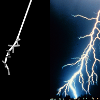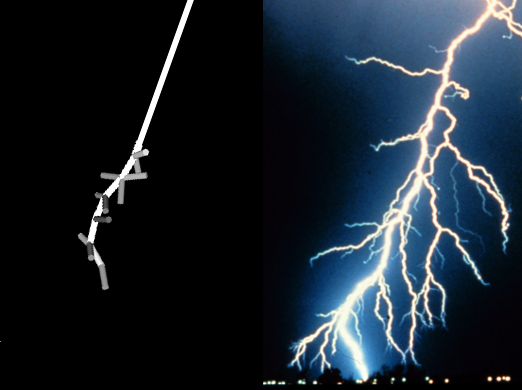Introduction
Lightning strikes kill about ![]() people every year1 and causes billions of dollars of damage to property2. Despite its crucial importance and being studied for hundreds of years, lightning is still poorly understood. The fundamental difficulty is the wide range of physics that is involved: electromagnetism, atomic physics, plasma physics, fluid mechanics, atmospheric chemistry, meteorology, and high-energy particle physics are all necessary to varying degrees. Not only is the theory complex, the observable phenomena range in scale from sub-millimeter electron avalanches to giant 100-km lightning bolts that span several states.
people every year1 and causes billions of dollars of damage to property2. Despite its crucial importance and being studied for hundreds of years, lightning is still poorly understood. The fundamental difficulty is the wide range of physics that is involved: electromagnetism, atomic physics, plasma physics, fluid mechanics, atmospheric chemistry, meteorology, and high-energy particle physics are all necessary to varying degrees. Not only is the theory complex, the observable phenomena range in scale from sub-millimeter electron avalanches to giant 100-km lightning bolts that span several states.
Lightning modeling
The VLF group at Stanford is engaged in many research projects to study lightning, largely by global lightning detection by our radio receiver network. One of our related projects is to develop a model of the lightning discharge process. This will help our understanding of lightning physics, help us interpret lightning signals in our radio data, and suggest techniques for prediction of lightning activity.
For modeling such a complex phenomenon, it is necessary to make some approximations. Here we have chosen to approximate lightning as a set of straight conducting or resistive channels that gradually extends under the influence of electric fields using the results of fractal lightning research (for example, see Riousset et al., 2007; Niemeyer et al., 1984; Pietronero et al., 1988; Femia et al., 1993, and references therein). In so doing, we capture the broad behavior of the lightning channel and the electromagnetic waves it produces, but ignore all of the small-scale physics that determines the exact behavior of the channel and the manner in which it extends. The results of such a simulation are the radio waves emitted, the shape, behavior, and duration of current pulses on the channel, and the overall branching structure of the channel. A sample produced by an early version of our simulation (Carlson, 2009, p. 96) is shown in above in Figure 1 next to a photo of a natural lightning discharge.
The model fills a niche in between small-scale simulations that treat the detailed plasma physics of breakdown and large scale simulations that ignore most of the details of the development and extension of the lightning channel. This, together with time-domain results for current and charge rearrangements and electromagnetic wave production makes this model very useful for meaningful studies of lightning. Development of the model is funded by DARPA under the Nimbus program.
Acknowledgement
This material is based upon work supported by the National Science Foundation under Grant No. ATM-0836326.
Any opinions, findings, and conclusions or recommendations expressed in this material are those of the author(s) and do not necessarily reflect the views of the National Science Foundation.
Bibliography
Carlson, B. E. (2009), Terrestrial gamma-ray flash production by lightning,
Ph.D. thesis, Leland Stanford Junior University.
Femia, N., L. Niemeyer, and V. Tucci (1993), Fractal characteristics of
electrical discharges: experiments and simulation, J. Phys. D. Appl.
Phys., 26, 619-627, doi:
rm10.1088/0022-3727/26/4/014.
Niemeyer, L., L. Pietronero, and H. J. Wiesmann (1984), Fractal
Dimension of Dielectric Breakdown, Phys. Rev. Lett., 52,
1033-1036, doi:
rm10.1103/PhysRevLett.52.1033.
Pietronero, L., A. Erzan, and C. Evertsz (1988), Theory of fractal
growth, Phys. Rev. Lett., 61, 861-864,
doi:
rm10.1103/PhysRevLett.61.861.
Riousset, J. A., V. P. Pasko, P. R. Krehbiel, R. J. Thomas, and
W. Rison (2007), Three-dimensional fractal modeling of intracloud
lightning discharge in a New Mexico thunderstorm and comparison with
lightning mapping observations, Journal of Geophysical Research
(Atmospheres), 112(D11), 15,203-+, doi:
rm10.1029/2006JD007621.

